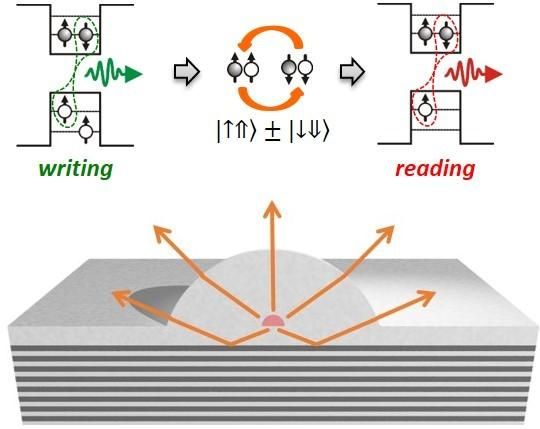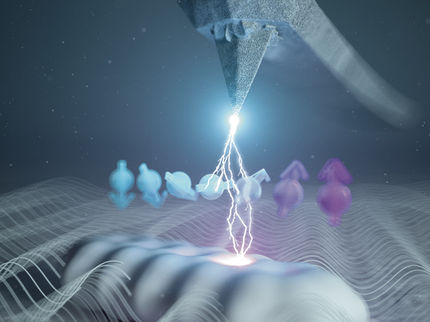Using the dark side of excitons for quantum computing
Advertisement
To build tomorrow's quantum computers, some researchers are turning to dark excitons, which are bound pairs of an electron and the absence of an electron called a hole. As a promising quantum bit, or qubit, it can store information in its spin state, analogous to how a regular, classical bit stores information in its off or on state. But one problem is that dark excitons do not emit light, making it hard to determine their spins and use them for quantum information processing.

The schematic illustrates the microlens device to measure dark excitons in a quantum dot. The left diagram depicts the spin-blockaded biexciton state that relaxes into a dark exciton and produces a photon; solid circles are electrons while empty ones are holes. The dark exciton then undergoes precession. To read the dark exciton, an extra charge carrier is introduced -- in this case, a spin-down electron.
Tobias Heindel
In new experiments, however, not only can researchers read the spin states of dark excitons, but they can also do it more efficiently than before. Their demonstration can help researchers scale up dark exciton systems to build larger devices for quantum computing.
"Large photon extraction and collection efficiency is required to push experiments beyond the proof-of-principle stage," said Tobias Heindel of the Technical University of Berlin.
When an electron in a semiconductor is excited to a higher energy level, it leaves behind a hole. But the electron can still be bound to the positively charged hole, together forming an exciton. Researchers can trap these excitons in quantum dots, nanoscale semiconductor particles whose quantum properties are like those of individual atoms.
If the electron and hole have opposite spins, the two particles can easily recombine and emit a photon. These electron-hole pairs are called bright excitons. But if they have the same spins, the electron and hole cannot easily recombine. The exciton can't emit light and is thus called a dark exciton.
This darkness is part of why dark excitons are promising qubits. Because dark excitons cannot emit light, they can't relax to a lower energy level. Therefore, dark excitons persist with a relatively long life, lasting for over a microsecond -- a thousand times longer than a bright exciton and long enough to function as a qubit.
Still, the darkness poses a challenge. Because the dark exciton is closed off to light, you can't use photons to read the spin states -- or any information a dark exciton qubit may contain.
But in 2010, a team of physicists at the Technion-Israel Institute of Technology figured out how to penetrate the darkness. It turns out that two excitons together can form a metastable state. When this so-called spin-blockaded biexciton state relaxes to a lower energy level, it leaves behind a dark exciton while emitting a photon. By detecting this photon, the researchers would know a dark exciton was created.
To then read the spin of the dark exciton, the researchers introduce an additional electron or hole. If the new charge carrier is a spin-up electron, for example, it combines with the spin-down hole of the dark exciton, forming a bright exciton that quickly decays and produces a photon. The dark exciton is destroyed. But by measuring the polarization of the emitted photon, the researchers can determine what the dark exciton's spin was.
Like in the 2010 experiments, the new ones measure dark excitons inside quantum dots. But unlike the earlier study, the new experiments use a microlens that fits over an individual quantum dot that was selected in advance. The lens allows researchers to capture and measure more photons, crucial for larger-scale quantum information devices. Their approach also lets them choose the brightest quantum dots to measure.
"This means we can detect more photons of the related exciton states per time, which allows us to access the dark exciton spins more often," Heindel said.
Measuring the dark exciton spins also reveals the frequency of its precession, an oscillation between a state in which the spins are either up or down. Knowing this number, Heindel explained, is needed when using dark excitons to generate quantum states of light that are promising for quantum information applications. For these states, called cluster states of entangled photons, the quantum mechanical properties are preserved even if parts of the state are destroyed -- needed for error-resistant quantum information systems.
###
The article, "Accessing the dark exciton spin in deterministic quantum-dot microlenses," is authored by Tobias Heindel, Alexander Thoma, Ido Schwartz, Emma R. Schmidgall, Liron Gantz, Dan Cogan, Max Strauss, Peter Schnauber, Manuel Gschrey, Jan-Hindrik Schulze, Andre Strittmatter, Sven Rodt, David Gershoni and Stephan Reitzenstein. The article appeared in the journal APL Photonics Dec. 19, 2017 (DOI: 10.1063/1.5004147) and can be accessed at http://aip. scitation. org/ doi/ full/ 10. 1063/ 1. 5004147 .
ABOUT THE JOURNAL
APL Photonics is the dedicated home for open access multidisciplinary research from and for the photonics community. The journal publishes fundamental and applied results that significantly advance the knowledge in photonics across physics, chemistry, biology and materials science. See http://scitation. aip. org/ content/ aip/ journal/ app .
Disclaimer: AAAS and EurekAlert! are not responsible for the accuracy of news releases posted to EurekAlert! by contributing institutions or for the use of any information through the EurekAlert system.
Share --> Print E-Mail
Media Contact
Julia Majors
media@aip.org
301-209-3090
@AIPPhysicsNews
http://www. aip. org
More on this News Release Using the dark side of excitons for quantum computing
American Institute of Physics
Journal APL Photonics Keywords ATOMIC/MOLECULAR/PARTICLE PHYSICS CHEMISTRY/PHYSICS/MATERIALS SCIENCES COMPUTER SCIENCE ELECTRICAL ENGINEERING/ELECTRONICS MATERIALS NANOTECHNOLOGY/MICROMACHINES NANOTECHNOLOGY/MICROMACHINES SUPERCONDUCTORS/SEMICONDUCTORS TECHNOLOGY/ENGINEERING/COMPUTER SCIENCE Multimedia The Schematic Illustrates the Microlens Device to Measure Dark Excitons in a Quantum Dot (IMAGE) view more Related Journal Article http://dx. doi. org/ 10. 1063/ 1. 5004147 More in Technology & Engineering New technique allows rapid screening for new types of solar cells Massachusetts Institute of Technology Metal printing offers low-cost way to make flexible, stretchable electronics North Carolina State University Robot drummer posts pictures of jamming sessions on Facebook Queen Mary University of London Using the dark side of excitons for quantum computing American Institute of Physics View all Technology & Engineering news Trending Science News Some monkeys prone to isolation University of Exeter The missing link between exploding stars, clouds, and climate on Earth Technical University of Denmark Consumer choices for the climate Norwegian University of Science and Technology Climate change may favor large plant eaters over small competitors National Institute for Mathematical and Biological Synthesis (NIMBioS) View all latest news
Copyright © 2017 by the American Association for the Advancement of Science (AAAS)
Breaking News RSS Feed All EurekAlert! RSS Feeds @EurekAlert facebook.com/EurekAlert Help / FAQ Disclaimer Privacy Policy Terms & Conditions Contact EurekAlert!
Copyright © 2017 by the American Association for the Advancement of Science (AAAS)
Original publication
Tobias Heindel, Alexander Thoma, Ido Schwartz, Emma R. Schmidgall, Liron Gantz, Dan Cogan, Max Strauß, Peter Schnauber, Manuel Gschrey, Jan-Hindrik Schulze, Andre Strittmatter, Sven Rodt, David Gershoni, and Stephan Reitzenstein; "Accessing the dark exciton spin in deterministic quantum-dot microlenses"; APL Photonics; 2017






























































